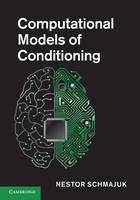
Computational Models of Conditioning
Cambridge University Press (Verlag)
978-0-521-11364-9 (ISBN)
Since first described, multiple properties of classical conditioning have been discovered, establishing the need for mathematical models to help explain the defining features. The mathematical complexity of the models puts our understanding of their workings beyond the ability of our intuitive thinking and makes computer simulations irreplaceable. The complexity of the models frequently results in function redundancy, a natural property of biologically evolved systems that is much desired in technologically designed products. Experts provide the latest advancements in the field and present detailed descriptions of how the models simulate conditioned behaviour and its physiological bases. It offers advanced students and researchers examples of how the models are used to analyse existing experimental results and design future experiments. This volume is of great interest to psychologists and neuroscientists, as well as computer scientists and engineers searching for ideas applicable to the design of robots that mimic animal behaviour.
Dr Schmajuk is a Professor of Psychology and Neuroscience at Duke University. He has developed and tested several neural network models of classical conditioning, operant conditioning, animal communication, creativity, spatial learning, cognitive mapping and prepulse inhibition. His previous books include Animal Learning and Cognition: A Neural Network Approach (Cambridge University Press, 1997), Latent Inhibition and its Neural Substrates (Kluwer Academic, 2002), and Mechanisms in Classical Conditioning: A Computational Approach (Cambridge University Press, 2010).
Introduction; 1. Evolution of attention in learning John K. Kruschke and Richard A. Hullinger; 2. The arguments of associations Justin A. Harris; 3. The hybrid modeling approach to conditioning Michael E. Le Pelley; 4. Within-compound associations: models and data James E. Witnauer and Ralph R. Miller; 5. Associative modulation of US processing: implications for understanding of habituation Allan R. Wagner and Edgar H. Vogel; 6. Attention, associations, and configurations in conditioning Nestor A. Schmajuk, Munir G. Kutlu, Joseph Dunsmoor and José A. Larrauri; 7. Computer simulation of the cerebellum Michael D. Mauk; 8. Towards a neural-network interpretation of the operant-respondent distinction José E. Burgos; Index.
| Erscheint lt. Verlag | 21.10.2010 |
|---|---|
| Zusatzinfo | 15 Tables, black and white; 44 Halftones, black and white; 30 Line drawings, black and white |
| Verlagsort | Cambridge |
| Sprache | englisch |
| Maße | 178 x 253 mm |
| Gewicht | 710 g |
| Themenwelt | Geisteswissenschaften ► Psychologie ► Allgemeine Psychologie |
| Geisteswissenschaften ► Psychologie ► Verhaltenstherapie | |
| Informatik ► Theorie / Studium ► Künstliche Intelligenz / Robotik | |
| Medizin / Pharmazie ► Medizinische Fachgebiete ► Pharmakologie / Pharmakotherapie | |
| Naturwissenschaften ► Biologie ► Humanbiologie | |
| Naturwissenschaften ► Biologie ► Zoologie | |
| ISBN-10 | 0-521-11364-4 / 0521113644 |
| ISBN-13 | 978-0-521-11364-9 / 9780521113649 |
| Zustand | Neuware |
| Informationen gemäß Produktsicherheitsverordnung (GPSR) | |
| Haben Sie eine Frage zum Produkt? |
aus dem Bereich


